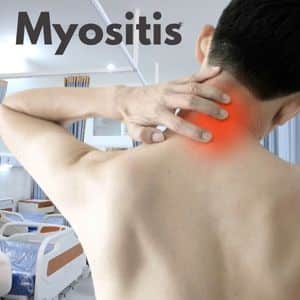Introduction: What is Myositis and Who is at Risk?
Myositis is a rare autoimmune condition that affects the body’s muscles and connective tissues. It has the potential to induce muscle weakness, fatigue, and pain. Myositis is most frequent in adults between the ages of 40 and 60, but it can also affect children and adolescents. Those with a family history of autoimmune disorders, specific genetic mutations, or syndromes, and those with other systemic illnesses such as lupus or rheumatoid arthritis are at risk for myositis.
Causes of Myositis
Myositis’s specific causes are unknown, however, it is thought to be an autoimmune disease in which the body’s immune system mistakenly targets its own muscle tissues. Genetics may potentially play a role in myositis development. Infection or exposure to certain drugs or toxins may cause myositis in some situations. Lupus, rheumatoid arthritis, and Sjogren’s disease may also raise the risk of getting myositis.
What are the Types of Myositis
Myositis is a collection of rare disorders that induce muscular inflammation and injury, resulting in weakening, discomfort, and, in some cases, disability. Myositis is classified into numerous kinds, including dermatomyositis, polymyositis, juvenile myositis, inclusion body myositis, and inflammatory myopathy.
What is Dermatomyositis
Dermatomyositis is a kind of myositis that affects the skin as well as the muscles. It causes a rash on the face, neck, shoulders, chest, and back, as well as muscle weakness and inflammation. Dermatomyositis can also cause problems with the lungs, heart, and digestive system.
Dermatomyositis Symptoms
Dermatomyositis is characterized by a characteristic skin rash, which frequently develops on the eyelids and face, as well as muscle weakness and exhaustion. The rash may emerge on the upper chest, back, and arms as well. Additional symptoms include swallowing difficulties, shortness of breath, joint discomfort, and muscular pain and tenderness.
What is Polymyositis
Polymyositis is a kind of myositis that primarily affects skeletal muscles, resulting in muscle weakening and atrophy. It frequently manifests as difficulties climbing stairs, rising from a chair, and lifting goods. Dysphagia, tiredness, and shortness of breath are additionally possible side effects.
Polymyositis Symptoms
Polymyositis is an autoimmune illness that causes inflammation and weakening in the muscles. The most common symptoms include neck, shoulder, hip, and back muscle weakness, as well as weariness, difficulty swallowing, shortness of breath, joint discomfort, muscle soreness and tenderness, and a skin rash.
What is Juvenile Myositis
Juvenile myositis is a kind of myositis that affects children and adolescents. It is distinguished by muscle weakness, a rash on the skin, and inflammation. Juvenile myositis can also impair the heart and lungs, making eating, swallowing, and speaking difficult.
What is Inclusion Body Myositis
Inclusion body myositis is a kind of myositis that affects older people and causes muscle weakness in the legs, arms, and fingers. It can also make swallowing and speaking difficultly, and it might damage the respiratory muscles. Inclusion body myositis is a slowly progressing condition with no existing cure.
What is Inflammatory Myopathy
Inflammatory myopathy is a set of muscular illnesses that produce inflammation and weakening in the muscles. It encompasses numerous kinds of myositis, including dermatomyositis, polymyositis, and inclusion body myositis. The cause of inflammatory myopathy is unknown, but it is thought to be an autoimmune condition.
What are the Signs & Symptoms of Myositis?
Myositis is an uncommon inflammatory muscle illness that causes muscle discomfort, weakness, and stiffness. It is critical to recognize the signs and symptoms of myositis in order to seek proper therapy. This article will go through the most frequent signs and symptoms of myositis, as well as how to seek medical attention if necessary.
Diagnosing Myositis – What Tests Are Used?
Myositis refers to a range of rare inflammatory muscle illnesses that can cause muscle weakening and pain. Myositis is difficult to diagnose because the signs and symptoms vary from person to person and laboratory testing is sometimes unreliable. Doctors use a mix of physical examinations, radiological scans, blood tests, and electromyography (EMG) testing to accurately diagnose myositis.
Treatment Options for Managing Myositis Symptoms
Myositis is often treated with a mix of pharmaceuticals, including corticosteroids and immunosuppressive drugs, as well as physical therapy and lifestyle adjustments. The goal of treatment is to minimize inflammation, regulate symptoms, and avoid consequences.
Alternative Therapies that May Help Manage Myosits Symptoms
While there is no cure for myositis, there are some alternative therapies that may assist persons with this condition to manage their symptoms and improve their quality of life. Nevertheless, before attempting these therapies, consult with a healthcare physician because they may interact with drugs or worsen symptoms in some circumstances. Here are some alternative therapies to consider:
Acupuncture is a traditional Chinese medicine method that includes inserting tiny needles into certain body sites to stimulate healing. Acupuncture has been proven in some studies to help reduce discomfort, inflammation, and muscular weakness in persons with myositis.
Massage therapy is the manipulation of soft tissues in order to promote relaxation, increase circulation, and alleviate pain and stiffness. Massage treatment may help persons with myositis improve muscle function, reduce discomfort and fatigue, and improve their general well-being.
Yoga and tai chi are mind-body techniques that include movement, breathing, and meditation. These treatments have been demonstrated to improve myositis patients’ muscle strength, flexibility, balance, and general quality of life.
Nutritional supplements, such as omega-3 fatty acids, vitamin D, and coenzyme Q10, may help reduce inflammation and improve muscle function in myositis patients. Nonetheless, it is critical to consult with a healthcare provider before using these supplements.
Mind-body therapies, such as meditation and relaxation techniques, may help persons with myositis reduce stress, anxiety, and sadness. These treatments may also improve one’s overall well-being and quality of life.
While some alternative therapies may be beneficial for symptom management, they should not be utilized in place of medical treatment.
Read More
